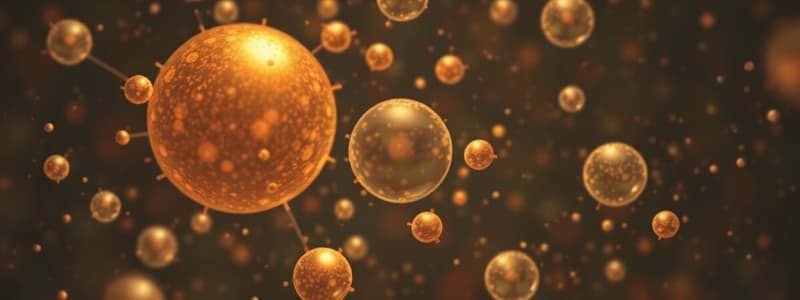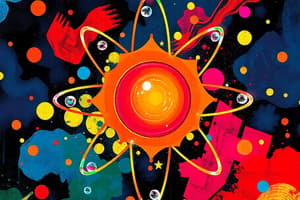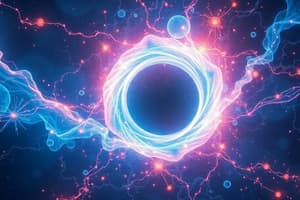Podcast
Questions and Answers
What is matter defined as?
What is matter defined as?
- Only solid substances that take up space
- Substances that can change states
- Elements that have no mass
- Anything that occupies space and has mass (correct)
Democritus proposed that matter is made up of tiny, indestructible particles called atoms.
Democritus proposed that matter is made up of tiny, indestructible particles called atoms.
True (A)
What does the term 'Vacuum' refer to?
What does the term 'Vacuum' refer to?
A volume of space that does not have any matter in it.
The basic particles that make up an atom are ____, ____, and ____.
The basic particles that make up an atom are ____, ____, and ____.
Match the scientist with their contribution to atomic theory:
Match the scientist with their contribution to atomic theory:
Which of the following is a pure substance?
Which of the following is a pure substance?
According to the atomic theory, atoms are physically indivisible.
According to the atomic theory, atoms are physically indivisible.
What are the two classifications of matter?
What are the two classifications of matter?
What are the particles found in the nucleus of an atom?
What are the particles found in the nucleus of an atom?
Atoms of one element can be changed into atoms of a different element through chemical reactions.
Atoms of one element can be changed into atoms of a different element through chemical reactions.
Who proposed the nuclear model of the atom?
Who proposed the nuclear model of the atom?
Each element is composed of extremely small particles called __________.
Each element is composed of extremely small particles called __________.
Match the following subatomic particles with their properties:
Match the following subatomic particles with their properties:
Which statement is true regarding compounds?
Which statement is true regarding compounds?
The nucleus of an atom has almost all of its mass concentrated within it.
The nucleus of an atom has almost all of its mass concentrated within it.
What charge does a proton carry?
What charge does a proton carry?
What is the charge of a neutron?
What is the charge of a neutron?
An atom is positively charged when it has more electrons than protons.
An atom is positively charged when it has more electrons than protons.
How do you calculate the number of neutrons in an atom?
How do you calculate the number of neutrons in an atom?
In a neutral atom, the number of electrons is equal to the number of ______.
In a neutral atom, the number of electrons is equal to the number of ______.
What happens to the number of electrons in a positively charged ion?
What happens to the number of electrons in a positively charged ion?
Electrons play a significant role in forming bonds between atoms.
Electrons play a significant role in forming bonds between atoms.
What determines the charge of an atom?
What determines the charge of an atom?
Match the following components with their respective descriptions:
Match the following components with their respective descriptions:
Flashcards
Atom
Atom
The smallest unit of an element that retains the chemical properties of that element.
Dalton's Atomic Theory: Identical Atoms
Dalton's Atomic Theory: Identical Atoms
Atoms of the same element are identical in mass and chemical properties.
Dalton's Atomic Theory: Conservation of Atoms
Dalton's Atomic Theory: Conservation of Atoms
Atoms cannot be created or destroyed in chemical reactions, only rearranged.
Dalton's Atomic Theory: Compounds from Atoms
Dalton's Atomic Theory: Compounds from Atoms
Signup and view all the flashcards
Nucleus
Nucleus
Signup and view all the flashcards
Protons
Protons
Signup and view all the flashcards
Neutrons
Neutrons
Signup and view all the flashcards
Electrons
Electrons
Signup and view all the flashcards
What is matter?
What is matter?
Signup and view all the flashcards
What are atoms?
What are atoms?
Signup and view all the flashcards
What is a vacuum?
What is a vacuum?
Signup and view all the flashcards
How can matter be classified?
How can matter be classified?
Signup and view all the flashcards
Who is Democritus?
Who is Democritus?
Signup and view all the flashcards
Who is John Dalton?
Who is John Dalton?
Signup and view all the flashcards
What is atomism?
What is atomism?
Signup and view all the flashcards
What is the Atomic Theory?
What is the Atomic Theory?
Signup and view all the flashcards
What is a neutron?
What is a neutron?
Signup and view all the flashcards
What are nucleons?
What are nucleons?
Signup and view all the flashcards
What are electrons? Why are they important in bonding?
What are electrons? Why are they important in bonding?
Signup and view all the flashcards
What is the atomic number of an element?
What is the atomic number of an element?
Signup and view all the flashcards
What is the mass number of an element?
What is the mass number of an element?
Signup and view all the flashcards
How can you determine the number of neutrons in an atom?
How can you determine the number of neutrons in an atom?
Signup and view all the flashcards
What is a neutral atom?
What is a neutral atom?
Signup and view all the flashcards
What is an ion?
What is an ion?
Signup and view all the flashcards
Study Notes
Matter
- Matter is everything that makes up the universe
- Anything that occupies space and has mass is matter
- Matter is made of tiny, indestructible particles called atoms (Democritus)
- Matter can be classified as pure substances or mixtures
- Vacuum is any space that doesn't contain matter
Atoms
- Democritus theorized that matter is made of tiny, indivisible particles called atoms
- Atoms are the basic building blocks of matter
- Atoms are made up of even smaller particles: protons, neutrons, and electrons
- Protons, positively charged, are found in the nucleus.
- Neutrons, neutral charged, are found in the nucleus
- Electrons, negatively charged, orbit the nucleus
- Protons and neutrons make up the nucleus
- Electrons reside in orbitals around the nucleus
- The nucleus is the dense center of the atom
- Almost all the mass of an atom is concentrated in the nucleus.
Subatomic Particles
- Protons are positively charged particles (+1 charge) found in the nucleus.
- Protons are composed of up and down quarks
- Neutrons have no charge (0) and are also found in the nucleus.
- Neutrons are composed of one up quark and two down quarks.
- Electrons have a negative charge (-1) and are found outside the nucleus in orbitals.
Atomic Structure
- Atoms have different properties based on the arrangement and number of their subatomic particles.
- Protons and neutrons are called nucleons
Early Discoveries
- Ancient Greek philosopher Democritus proposed the idea of atomism
- John Dalton, an English schoolteacher, developed the Atomic Theory based on the Law of Conservation of Mass and the Law of Constant Composition.
- Dalton's atomic theory included the ideas that elements are made of atoms, atoms of an element are identical, and compounds are formed when atoms combine.
Particulate Terminologies
- Atoms define chemical elements
- Atoms are the basic units of any specific matter
- Electrons are free-moving particles and are involved in chemical processes, such as forming or breaking bonds.
- Interactions of electrons and other properties cause chemical bonding.
How to determine the number of protons, electrons, and neutrons in an atom:
- Number of protons = atomic number
- Number of electrons = atomic number (in a neutral atom)
- Number of neutrons = mass number - atomic number
Atomic Number
- The atomic number represents the number of protons in the nucleus of an atom.
- The atomic number determines the element's chemical properties
- The atomic number is located at the top left corner of the element's box in the periodic table.
- The atomic number is equal to the number of protons
Molecules
- A molecule is a group of two or more atoms bonded together
- Molecules represent the smallest identifiable unit of a pure substance.
- Molecules can be simple, complex, or even repeating units
- Molecules retain the chemical properties of that substance.
- Molecules form when atoms bond together
- Examples include H2O (water), O2 (oxygen), CO2 (carbon dioxide), and CH4 (methane)
Studying That Suits You
Use AI to generate personalized quizzes and flashcards to suit your learning preferences.




